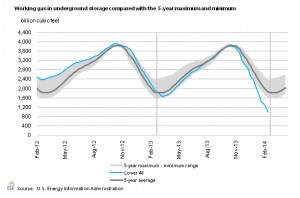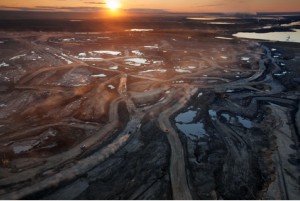 … a pipeline of wind and solar projects!
… a pipeline of wind and solar projects!
by Glen Estill
Gas in storage continues to decline at an alarming rate. Natural gas in storage has dropped to 1,000 billion cubic feet. This is 49% below the same time last year, and 46% below the five-year average. Gas in storage dropped by 195 billion cubic feet (Bcf) the first week in March this year. Last year in the same week, the gas in storage barely dropped. Gas consumption has been high due to the cold weather, especially in the densely populated US northeast. Temperatures seem to be rising somewhat, but the long term weather forecast in the most populated areas of Canada, at least, is predicted to have below normal temperatures until the end of May. The heating season will be extended, but will not be as intense as the rest of winter.
The result of less gas available is a rather dramatic increase in price. Enbridge, supplier of gas to Toronto and much of central Ontario has applied for a 40% increase. The price at the benchmark setting Henry Hub has recently been as high as $7.98, and is $4.67 per million BTUs at this writing. This compares with $2.17 (U.S.) a year ago. Home heating prices are of course much higher due to transmission and distribution costs.

The Keystone Pipeline will result in the release of an additional 181 million metric tons of carbon into the atmosphere every year, which is the same as adding nearly 38 million cars to the road or 51 new coal plants to the planet. The question isn’t if the pipeline will impact climate change, but exactly how devastating it will be.
Photo: inhabitat.com
Demand for gas has increased due to the weather, the switch to gas-fired power generation, and even the conversion of fleets to compressed natural gas. Industrial demand for gas has rebounded, as the North American gas price became cheaper than other places in the world. The increase in price is likely to hold, but natural gas companies will need the higher price to find, pump and frack enough gas to replenish supplies. LNG export plants, as proposed around the continent, may be negatively affected as we find that perhaps we don’t have the surplus gas we thought we did.
The most efficient gas power plants use about .7 BTU of gas per kWh. So that means the fuel cost alone, excluding transmission and distribution is 3.6¢/kWh. Less efficient plants like the Lennox plant use 1.1 BTU per kWh. The transmission cost needs to be added, as well as plant operation, depreciation, debt payments etc. The cost of electricity across North America will be higher.
In the spring, water flowing to hydro reservoirs increases dramatically, further cutting our need for gas to generate power. More solar and wind production allows us to burn less gas to generate electricity. And with the decline in gas supplies, and higher price, this output is increasingly important to curtail the higher cost of generating electricity, heating and other uses of gas. About 32% of natural gas consumption in 2013 in the US was for power generation, which is very significant, and the largest use by type, ahead of industrial and residential home heating demand.
We should get on with building the pipeline — of wind and solar projects now.
Source: Paul Gipe’s Feed-in tariff news update. pgipe@igc.org
Glen Estill is the president of Sky Generation, Inc., Lion’s Head, Ontario. This blog was posted originally on March 13, 2014. wind-blog.com.








Leave a Reply